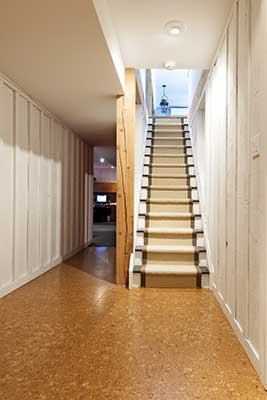Home Is Where Nature Is
Use of biomaterials is the New Normal in the design of home spaces. Applications are appearing every other day to help us make the shift to eco-ethical living—from bast fibre furnishings to bamboo and recycled wood furniture to mushroom lampshades and pineapple leather décor pieces and more, the canvas is only expanding.
Global warming and climate change is a threat that continues to hang over us like the sword of Damocles. And worldwide, there is a movement that is finding ways to protect the earth, our world, our home. Today, eco-friendly and zero-waste products have become the rage. So also have sustainable and environmental-friendly homes.
For a while now, sustainable living has been extending beyond daily practices. This year it is set to storm and roost in the realm of home decor. Conscious of the environmental impact of our choices, eco-friendly options are in place in the marketplace—offering furniture, materials and lighting to create stylish but eco-friendly living spaces.
Biomaterials are playing a central role in this evolution. From bast fibre carpets, towels, curtains and beyond to bowls crafted using reclaimed wood waste or sawdust, innovative uses are underscoring a harmonious coexistence with nature. Taking a step into the future, vegan decor options too are in jet mode and plant-based and cruelty-free materials such as pineapple leather (Piñatex) and mushroom leather (mycelium) are gaining popularity for furnishings and other accessories.

best fibres
Commonly known as ‘soft’ fibres, bast fibres derived from the inner bark of certain plants have been used to manufacture ropes, sacks, sails and other industrial fabrics for hundreds of years. Think flax (linen), hemp, jute…. Now, since they support regenerative agricultural practices and are entirely biodegradable, they are finding a prominent place in home textiles.
Carpets, towels and curtains made from these biomaterials are durable, versatile and inherently sustainable. Hemp and linen, for instance, even offer a luxurious and natural aesthetic, adding a touch of organic elegance to home interiors. Linen revered for its relaxed beauty exudes casual sophistication, while its organic texture and anti-bacterial properties promise both durability and versatility. Hemp, naturally occurring in shades of yellow, green or brown, blends well with cotton to exude a similar feel.
Bengaluru-based architect and designer Saikat Bhattacharyya is effusive in praise: “Linen and hemp make for eye-catching drapery, upholstery, cushions, bedding and tableware. Linen is especially stunning as loose cover in upholstery.”

After suffering competition from synthetic alternatives for decades, even jute is in demand. And not just for the cliched bags. Jute carpets are in vogue; so are textiles. The fibre is now sought as insulation material, just like hemp, another incredibly multi-purpose fibre. As a matter of fact, biomaterials are now top choice as sustainable alternatives for structural elements.


floor and more
Biomaterials, emerging as a gentle giant in the construction and design realm, is weaving a future where our dwellings will not only be shelters but harmonious extensions of the environment. Carpets made from plant-based fibres or recycled materials are offering eco-friendly alternatives to synthetic carpets. “We now have customers walk in and ask for eco-friendly carpets. Such preferences were unthinkable even a year ago,” says Kulen Kalita, manager of Guwahati-based store, Vinayak Furnishings.
Besides contributing to healthier indoor air quality, jute, wool, bamboo, sisal and seagrass unique, one-of-a-kind pieces that tell stories through their imperfections and natural variations. Cork, harvested from the bark of cork oak without harming the tree, has also found its way into India—a naturally textured material that is not only being used in flooring but also as wall tiles and acoustic insulation.
eco enhancements
Accessorising the home is as old as the trees. Now, with a broader shift towards sustainable living practices, décor pieces using biomaterials are offering eco-friendly alternatives to arrest the eye. Innovation in materials and technology is constant and so today you even have intricate and visually-interesting mycelium and Piñatex lampshades and even stand-alone 3-D art pieces!
In fact, slowly but surely, Piñatex is being woven into rugs, made into cushions, pillows, throws, tablemats, coasters, and even room dividers! Seagrass and bamboo, of course, has been around for some time in their crafting into similar products—bamboo preferred in the northeast of India and other south and east Asian countries even as furniture; but now the range and aesthetics of the products are wide and unique.



Then there are photo frames, vases, planters, wall art, coasters crafted from these biomaterials—all of which will not only add warmth, texture and elegance, but will also set your home apart. Today, decor pieces, tiles and countertops made from bio-composite materials—combining agricultural waste with bio-resins—even mimic the appearance and feel of stone without impacting the environment.
In the delicate weave of modern living, the choice of materials that cocoon our homes is more than a matter of aesthetics. It is a reflection of our responsibility towards the planet. Imbued with organic textures and earthy hues, they offer a tranquil and nurturing atmosphere in your living spaces—a stark contrast to the cold, industrial embrace of conventional materials. From cultivation to disposal, these materials leave minimal impact on the environment, decomposing naturally and returning to the earth without leaving behind any legacy of pollutants.


